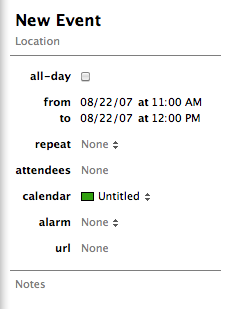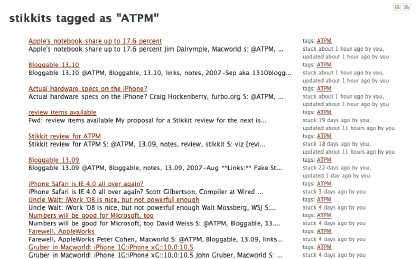Software Review
Stikkit

Stikkit has some great status messages. Someone clearly thought long and hard about them; even the verbiage—“You stukkit” appears when you save a new note—is really very smart.
That’s Stikkit’s initial selling point, too. Stikkit is a Web service for notes, to-do lists, appointments, and contacts, and what sets it apart from other notes programs is that it operates on its own smarts. It uses keywords and some simple (keyword-noun) processing as a subset of natural language to discern what you want out of each note. This can be a big advantage; rather than the specialized interfaces that iCal and Address Book have for entering new data, where you type in data into the “Title” field, the “Start Time” field, the “End Time” field, etc., you enter what I typed the other day:
Meet with Todd on July 17 from 12 PM to 12:30 PM in the cafeteria at work.
Stikkit, which is owned by Portland, OR–based start-up Values of N, is smart enough to process that to mean “New appointment from 12 PM to 12:30 PM on Tuesday July 17.” If I’ve got everything set up, it also links the appointment to my contact entry for Todd. iCal would have required me to enter all of the useful information in all of the right spots, so that I’d use the mouse or the Tab key a couple of times and make sure that the format was just right. This all works by using a handful of magic keywords.
Talk about amazing. The first time I did this, I thought, to myself, This is how this should be.
What’s more impressive still is that Stikkit has a wide variety of uses. And that’s why I’m here this month, to tell you about all of the various ways that you can make Stikkit part of your life: on your Mac and from your Web browser. I’ve gone from being a skeptic, even after I discovered how easy it is to create a new appointment or contact, to being a user, using Stikkit to store virtually everything digital.
There are a few preliminary details we need to talk about first, though. There are five basic types of Stikkit entries: notes, appointments, to-dos, contacts, and bookmarks. Stikkit, for reasons I don’t entirely know, calls these “stikkits,” “calendar,” “to-do list,” “peeps,” and “bookmarks,” respectively. I’ll use Values of N’s nomenclature for the rest of this review. A stikkit is the most generic of all of the types; any stikkit can contain three of the four more specialized items. A peep must stand alone in its own stikkit, with the first line reading “name.” But a single stikkit could be a note, an appointment, a to-do list, or a URL. Each of these three secondary categories is really just metadata that can be applied to a stikkit, and it’s been most helpful to me to think of them that way.
(An aside: Why not call them “notes” and “contacts”? I don’t work at Values of N, which operates Stikkit, but if I did I would tell the developers that it’s silly to change the names like that arbitrarily. Not to knock too much on my homeboys—a shout-out for Portlanders everywhere!)
There’s other metadata associated with a stikkit. Each has an ID, which is part of its URL, and an a.k.a. You can refer from one stikkit to another anywhere in the text, just by putting curly braces around the other stikkit’s a.k.a., and you can set a stikkit’s a.k.a. if you like (or Stikkit will auto-generate one for you). Each also has an e-mail address, so that if you send e-mail to a stikkit, the text will be added as a comment; each can be set to notify you fifteen minutes in advance of an event time; each can be associated with a (theoretically) infinite number of peeps; and each can have an (also theoretically) infinite number of tags.
Several of these are basically free-form applications, and that’s what’s most useful. You can set an a.k.a. to whatever you want and use that to refer to a stikkit wherever you want in the text of another stikkit. Any time you refer to someone by full name in the text of a stikkit, Stikkit will automatically create a new peep by that name. And by starting a new line with an @, you can associate a stikkit with however many tags you want, including new ones.
What’s beautiful about all of this is that even the most complex applications for Stikkit are still fairly simplistic. I’ve used a variety of complicated information-filing systems—Bare Bones’ Yojimbo, my boss Michael Tsai’s EagleFiler, Copernican’s Boswell, Flying Meat’s VoodooPad…the list goes on and on. None of them was ever at once so easy to create a new, simple entry and so powerful at creating a complex entry.



It’s much easier to create a new stikkit than in either Address Book or iCal. Everything is free-form data in Stikkit, so there’s no button-punching or tabbing.
Everything else in this part of the market is either not powerful enough for my needs or too focused on a particular kind of data. The worst offenders are the ones that have a particular fixed set of formats.
All you have to do to create a stikkit is to click the “New stikkit” button. There’s also a Quicksilver plug-in that allows you to post single-line stikkits (or append new items to an existing stikkit) and an OS X Service to “post new stikkits.” And Stikkit has an e-mail interface that creates a new stikkit out of any e-mail you send to it.
So now, I believe you know what you need to know about the way that Stikkit works. I could go on describing how to use Stikkit, but rather than tell you how to write notes like this one:

Even a comparatively complex stikkit has a very straight-forward format. I was even able to interleave a few notes in the date entry, and it still gets scheduled correctly.
I’d like to explain how you can leverage Stikkit to make life easier for yourself. I think you can figure out how to structure a stikkit. (If you’re having trouble, check Merlin Mann’s really great Stikkit cheat sheet.)
Pretty much everything in my life goes in Stikkit. A lot of it is very free-form, in a way that consciously mimics what I’ve long done with a Moleskine notebook. So, for instance, a typical stikkit would be a list of things that I need to do today, intermingled with notes on what I need to do with all of those things, and sometimes just random thoughts that occur to me throughout the day. I also input all of my appointments with specific times, including my work schedule (it’s very complex). And I forward or Bcc most important e-mails to the service’s e-mail address for creating new stikkits, so that they can be cross-referenced to other elements in the Stikkit database.
As long as everything has as many possible tags as I can think of—it’s much easier to over-tag and remove one you don’t need than to under-tag and need to add a new tag to a lot of items—you shouldn’t have any trouble finding older items. When there’s anything you know you want to be able to access directly from one stikkit to another, link it together using curly braces and the a.k.a. of the item you’re referring to, like {a.k.a.}. Most of the time, though, I get by just by browsing tag listings.

What you get when you browse through, for instance, my “ATPM” tag. Look, Ma, next month’s Bloggable column!
Now all that’s left is interfacing Stikkit with the rest of your life. In addition to keeping the main Stikkit page open in my Web browser, which gives me an agenda view of the next week or two, I have hammered out what I think is a considerable number of other uses for my Stikkit data.
- I subscribe to three feeds: one, my main Stikkit RSS feed; two, the feed of not-yet-done to-dos, which show me new and upcoming stikkits as updates become available; and three, an RSS version of the next week’s upcoming events. I’ve tried to think of a way of fine-tuning this, so that each morning I could have a list of that day’s appointments, but Stikkit insists on returning events on the next day even when you ask for a specific date. Anyway, here is a main Stikkit RSS feed, a Stikkit to-do feed, and a calendar RSS feed.
- I also have iCal subscribed to my Stikkit iCal feed. That, plus Missing Sync, gives me my Stikkit calendar on my Smartphone and on my PDA.
- I’ve bookmarked certain tags that allow me to organize what I’ve got going on. So, for instance, the “work” tag contains my work schedule, notes on work stuff, and any work-related appointments I have; and the “ATPM” tag contains a ton of notes and links and the like. That gives me very quick access to particular commonly used receptacles for data.
Stikkit has a few limitations, unfortunately. One of them is that if, like me, you have the dreadful habit of forgetting what a stikkit was called, it’s going to be awfully hard to sift through your old stikkits, especially if the tags you remember are common ones. I’ve fantasized about an e-mail-like interface to stikkits, which would be awesome but also very difficult to do, since it would still have to go page by page of 25.
Another limitation is that stikkits are always sorted by their modification date. Alphabetical sort would be nice; so would creation date, which, oddly enough, you can search by but not sort by.
A third is that there’s currently no way to input anything other than plain text into Stikkit. I’d pay $10 a month for the ability to attach files to Stikkits alone; how many times have I exclaimed, “Why can’t I just attach this file to this?!” (Last count: 13, since I started keeping track. Probably a few before then.)
But these are not insurmountable hurdles. I think Stikkit has turned out to be a terrific way to organize my life—data entry is easy and free-form, and it gives me a good and easily sorted home from data in a format I can access at home, from work, on my phone, via e-mail, and with anything that can read RSS.
What could be wrong with that?
Reader Comments (1)
http://interblah.net/2007/4/3/stikkit-dashboard-widget
Add A Comment